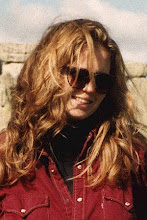
After visiting the salt flats in Uyuni, the largest and highest salt flats in the world, we set off to Laguna Colorada in the deep south-west of Bolivia. You haven't missed the blog about Uyuni or Laguna Colorada yet, I still need to write them. Please be patient.
I do like Bolivia, don't get me wrong, but as someone brought up in Europe, there is one essential thing missing: paved roads. Almost all the way down from La Paz to Uyuni and then on to Laguna Colorada, there were NO bloody roads. Dirt tracks, some tracks left by other drivers and we did actually need a guide to direct us to the Laguna. I had a seat at the very back of the truck and it did my back in a bit. Although Renee, our tour leader, let us use the roof-top seats for a while so we could enjoy the stunning scenery a little more, I'm a city kid at heart and it took me half a bottle of shampoo to get the dirt out of my hair.
But why am I talking about Bolivia when the title of the blog is Chile? Well, what a bleeding nightmare that was. After negotiating the Bolivian border without any problems, we hit the "tarmacked" road (cheers throughout the truck) leading through "what we thought it to be and trucks used to get away with it" a 60-kilometre stretch of so called no-man's land to Paso Jama, the Argentinian border. Well, suffice it to say, we didn't get away with it. When the Argentinians saw that our passports had a Bolivian exit stamp, they refused to let us in because, officially, we had come through Chile. So we had to get back on the truck, turn it around, drive some three hours to San Pedro de Atacama where we were searched top to bottom and finally let in. After a quick dinner, we pitched our tents at midnight at the back of some hostel and left quite early in the morning for the road we had started to call our home. Around lunchtime we finally hit the Argentinian border again and now, in possession of a valid Chilean entry and exit stamp, they let us in without any problems.
Lots of stunning images on the way - especially the clouds.
















 Ever since Erich von Däniken first mentioned the strange lines on the Nazca altiplano, I was hooked. Could it really be that aliens had created them? Or was the archaeologists' outcry that they had been created by the ancient Nazca people justified? Flying over the lines in a small four-seater Cessna plane, I got a first-hand view and could clearly see the lines criss-crossing each other without any apparent plans wasn't it for those that clearly depicted figures. There was the monkey with its curled up tail, the colibri with its long beak and the friendly figure up on a little mountain waving at us. This figure is called the astronaut. Astronaut? Well, it could easy be a figure of a being from outer space. But the archaeologiest have taken the fun out of it again and now proclaim that it is an owl-man. Did the ancient Nazca people really have a similar association we have have with owls? But the truth is, that we are actually none the wiser with this interpretation. The riddle of the lines has still to be cracked - but in whose interest would this be? Wouldn't the aura of mystery - such as described by von Däniken - be the one to be followed as it brings scores of knowledge-seeking tourists to this barren place and it helps to keep its economy afloat?
Ever since Erich von Däniken first mentioned the strange lines on the Nazca altiplano, I was hooked. Could it really be that aliens had created them? Or was the archaeologists' outcry that they had been created by the ancient Nazca people justified? Flying over the lines in a small four-seater Cessna plane, I got a first-hand view and could clearly see the lines criss-crossing each other without any apparent plans wasn't it for those that clearly depicted figures. There was the monkey with its curled up tail, the colibri with its long beak and the friendly figure up on a little mountain waving at us. This figure is called the astronaut. Astronaut? Well, it could easy be a figure of a being from outer space. But the archaeologiest have taken the fun out of it again and now proclaim that it is an owl-man. Did the ancient Nazca people really have a similar association we have have with owls? But the truth is, that we are actually none the wiser with this interpretation. The riddle of the lines has still to be cracked - but in whose interest would this be? Wouldn't the aura of mystery - such as described by von Däniken - be the one to be followed as it brings scores of knowledge-seeking tourists to this barren place and it helps to keep its economy afloat?













